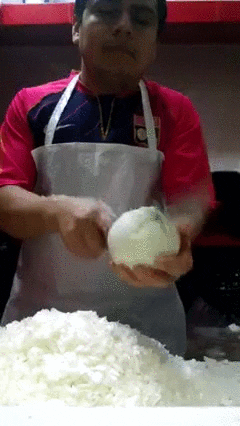I don’t know about you but for me cutting onions is a torturous process. I can’t stop crying every single time! So I’ve decided to investigate: why do we cry and how can we stop it?
I’m clearly not the only one asking that question as this is the first that pops up when we ask “why onions” to Google.
Fortunately, it seems researchers have some insights on the chemical reactions behind this phenomenon!
According to a Japanese team (who published this in Nature, no big deal), when we cut into an onion, it activates a particular defense mechanism: the damaged cells release an enzyme, called the lacrimatory factor synthase (that’s quite a self-explanatory name, right?). This enzyme, then, comes into contact with another molecule and produces a sulfenic acid called syn-propanethial-S-oxide or, in proper English, the lacrimatory factor.
This lacrimatory factor is highly volatile and quickly go straight into our eyes where it transforms into sulfuric acid. The eye is densely populated with sensory fibers of the trigeminal nerve that interpret this molecule as a pain signal. To wash away the irritant, our brain then decide to make us cry.
This whole process is quite useful for the onions as a defense mechanism against predators. And it’s so efficient that several patents for nonlethal deterrents against thieves and intruders were inspired by it!
By understanding this chain of reactions, we can now look for ways to avoid crying when cutting onions!
First, we can try to avoid the lacrimatory factor that is floating around when we cut into an onion. For that, we can :
Run water onto the onions to flush away the compounds
Cut them while submerged in water
Or even buy a scuba mask to protect our eyes!
Then, we can also try to avoid the reaction that produces the lacrimatory factor by:
Lowering the onions’ temperature, either with a fridge or a freezer, as this will slow down the enzymatic reaction
Cutting them with a really sharp knife as this will reduce the damage done to the onions cells
We can also try to reduce the amount of the lacrimatory factor’s precursor in our onions. For that, we can:
Avoid damaging the part near the root when slicing our onions : this molecule is in higher concentration there
Choose onions that are fresher, as the amount of this molecule increases during storage
Choose onions that has been grown in a low sulfur environment : one hypothesis is that the more sulfur the onions absorb from the ground, the more eye-tearing they would be
Choose onions that has been selected for their low amount of the precursor : for example Bayer developed an onion breed, called Sunion, that has been crossbred to lower its pungency
Maybe with this type of onions, one day I’ll be able to bite into one like this little kid!
Lastly, another strategy to avoid tearing up in the kitchen would be to reduce the amount of lacrimatory factor synthase, that pesky enzyme that starts the whole process. To do so, we can :
Blanch the onions, by putting them in boiling water then plunging them into freezing cold water : this will denature the enzyme, but could also affect the texture of our onions
If we want to be radical, we can also play around with the genome of the onions to make sure that the lacrimatory factor synthase never even appear. That was done by a group of researchers who managed to use a gene silencing technology to suppress the enzyme.
However, as the tear-inducing molecule is also responsible for the pungent taste of the onions, if we suppress the first, we could definitely affect the second. And then, could they still be called onions, without that particular and characteristic flavor?
Thank you for your attention! Let me know what you are your strategies to avoid crying!
Sources :
Imai, S., Tsuge, N., Tomotake, M., Nagatome, Y., Sawada, H., Nagata, T., & Kumagai, H. (2002). An onion enzyme that makes the eyes water. Nature, 419(6908), 685-685.
Eady, C. C., Kamoi, T., Kato, M., Porter, N. G., Davis, S., Shaw, M., ... & Imai, S. (2008). Silencing onion lachrymatory factor synthase causes a significant change in the sulfur secondary metabolite profile. Plant Physiology, 147(4), 2096-2106.








